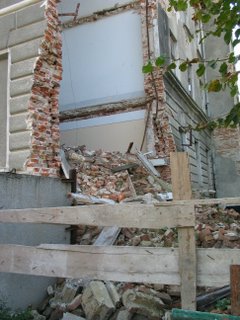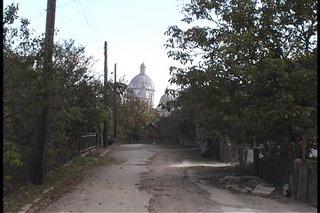The Ukrainnian-American diaspora and English-language publication The Ukrainian Weekly has a piece about Pidhajtsi on its front page this week! The article is about efforts to restore the town's Cultural Center (I prefer to translate Narodnyj Dim as Cultural Center) and a plan whereby the State would pay for 95% of the project--locals will have to come up with 5% of the cost for the renovation. Read the full article here.
Here is my response to the article that I am sending (in a more edited and scaled-down version) to the weekly:
I was very pleased to see the article, published on the front page of your paper, about the town of Pidhajtsi in the state of Ternopil. I was born in Minneapolis, the grandson of Maria and Michael Iwaskewycz, who were born in the village of Sil’tse near to Pidhajtsi, and who funded the construction of a new Catholic Church in their village and another in Pidhajtsi itself. I was in Ukraine from the spring of 2004 to the spring of 2005 and experienced first hand the Orange Revolution, and I recently returned for another three months to work on a documentary entitled, Whose Revolution was It?: The Orange Revolution One Year Later.
The infrastructural problems in Ukraine are vast and bewildering, and the state of decay of the Cultural Center in Pidhajtsi is a case in point. It is very good that money is being raised to improve this building; and although it is natural that people should want to see improvements to public places such as this center and to Churches, there are many more pressing infrastructural needs in Pidhajtsi. That is, Pidhajtsi offers an even more significant, and terrible, example of these problems of infrastructural neglect and decay that so plague much of Ukraine: Last year, just before the first round of presidential elections, a portion of the top two floors of the three-story gymnasium collapsed. Only pure luck determined that this happened on a Saturday, with no students in the building. Some reporters from the Western Ukrainian press came to Pidhajtsi at the time to make this point, asking: What if? What if it had happened on Monday? This of course was already on most people’s minds in Pidhajtsi, and at the time many explained to me that, “We know our buildings are old; who does anything for them?” Any viewer watching the report in Ukraine could easily have recognized in this an example of the general neglect everywhere in Ukraine.
Post-Soviet authorities in Ukraine have been utterly careless regarding the people and neglectful of their duties to them. A huge gulf has separated the narod (the people) and the government functionaries, and it is the same at the local level as it is at the top levels. Money has been allocated for infrastructural repair and maintenance, but has disappeared. Roads are ordered repaired, but only the bare minimum is done, as a chunk of the allocated funds lands in someone’s pocket. The roads in Pidhajtsi are just short of a total catastrophe, and people know it. Some weeks before the Orange Revolution, I met an old man walking down a steep and deeply rutted road late on a night with no moon, and the street lamps are never lit at night: Is it due to budget cuts, lack of funds, or corruption? Who knows. He was having a difficult time managing, and as I began to help him along, he thanked me and complained bitterly that we should go together to take the city mayor, “by the balls until he does something [to fix the road].” A very common question in my months in Pidhajtsi was, “So, what do you think of our roads!?” Occasionally one can spot a bumper sticker, usually placed on Western-made cars, that reads “I WANT TO GOT BACK TO EUROPE.” Ukrainians joke about their roads because they know their roads are a joke.
People were, and still are, angry. Water pumps and pipes, electric power lines and transformers, etc., all remain old, worn-down, and are prone to breaking down. Many times in Pidhajtsi, both before and after the revolution, there was no water on our street, either because a number of people had not paid their bills and the water was deliberately shut-off (the jointly, privately-publicly run utilities still assign collective responsibility), or because a pump had broke. This was the case just this past August and September; for at least a third of this time no water ran to houses. People had to haul water home from public wells.
In Western Ukraine especially, the whole of the infrastructure chugs along with the help of band-aids and knee braces, and only the occasional cup of coffee keeps these senior citizens running. They should all be retired and younger ones put in their place.
The Orange Revolution has been hailed as the birth of a Ukrainian civil society that fills in the gulf between the people and the government, and Yushchenko promised massive infrastructural improvements. Is this true? Are things changing?
Things after the OR are going like this: There also is a plan for a massive road improvement project in the Pidhajtsi county, but, just as with the Cultural Center, people have to put up a percentage of the funds in donations before Kyiv will send the rest of the money.
Some of the people I talked to in Pidhajtsi approved of the plan, arguing that this is a way of teaching people that they must share some of the responsibility for the state of things in Pidhajtsi and for improving them; others complain that this is just a part of a growing list of betrayals of revolution promises. Such people feel that oligarchs should be made to pay for the infrastructure that they have been neglecting, and that immunity for local officials only guarantees that the money locals would raise and that would come from Kyiv will be stolen once again. To my mind, it is not an either/or question; both are right. Ukrainians should learn to take more responsibility themselves and take some of it away from the State, but the oligarchs should be forced to pay up, too. Remember that Ukraine technically should not be a country of poor people. Recall that Pinchuk and Akhmetov are Forbes Billionaires while 55% of the population lives below the international poverty line and suffer 25-50% unemployment rates, depending on region and season. And given that corruption remains a large problem especially in the rural areas, the law on local autonomy is nothing but absurd.
About Pidhajtsi's Cultural Center, I have enjoyed many a concert at that Cultural Center with many a fellow Pidhajechany, most recently on last Oct. 14, or UPA day. This Cultural Center should always be remembered as the place where people met, nearly a year ago in mid-November, to discuss what became known as the "budget-worker scandal." A plan was hatched by the presidential administration to vote in the second round of last year's election debacle on behalf of all those in Ukraine whose wages are paid by the State budget. The day after the order came that all budget workers should turn over their voting registration cards and passports to their managers, who would in turn vote on their behald on Nov. 21, meetings and pickets broke out all over Ukraine. State officials and managers of State-run businesses claimed that they intended only to make it easier for budget workers to attend election day festivities. In the Cultural Center in Pidhajtsi, an angry group of people gathered to denounce the order and to shout down the names of people known already to have turned in their documents. After the meeting, angry pickets were held in front of the local police station and of the county administration buildings. Due to similar expressions of outrage all across the country, the presidential administration was forced to back down on this method of falsifying the election. However, as one well knows, they had plenty other, equally-as-obvious, tricks up their sleeves.
That something is being done to improve the Cultural Center in Pidhajtsi is, despite the above concerns, indeed a good example of the positive difference the Orange Revolution is having in Ukraine. Most of all, however, the people of Pidhajtsi should be applauded for raising 5% of the funds, and for taking the good-natured step of trusting that the money will be used for its intended purpose. I hope they will not be let down.
Photos of the collasped gymansium in Pidhajtsi, as it still stood one year later this fall.

 One of the culprits causing the occassional power-outtage:
One of the culprits causing the occassional power-outtage:
A typical road in Pidhajtsi:

This photo is a still from some of my video footage; somehow I never managed to photograph the roads! This is Pidhajsti, and in the background is the dome of the Catholic Church for which my grandfather, who passed away three years ago this November, was the primary founder.






No comments:
Post a Comment